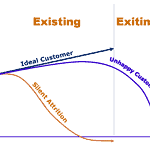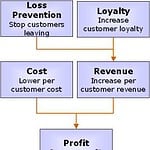Competition is tougher than ever before and many companies are out prospecting like mad for new customers. However, most don’t realise that the fastest, cheapest and lowest risk way of protecting their business is not finding new customers, but nurturing existing customers. I know you’ve heard the old adage – that it’s easier to sell to an existing customer than a new one; well it’s true and now is the time to take it to heart.
Right up front though there is one founding approach to customer retention management that will dramatically increase your effectiveness: have a bias towards action.
Planning is always important but it is better to start with an initiative that is 80% right and improve it over time than wait until it’s 100% right. While you plan, your competitor is making inroads into your customer base.
But remember that because not everything is perfect when you start and you need to fine tune as you go. Test different approaches, try different ideas, keep the ones that work and discard the others. This also helps you to adapt to the changing market and business requirements.
Which are your valuable customers?
Before you start on any customer retention initiatives you first need to determine which customers are more valuable and which are less valuable. This is important to ensure that you really look after the most valuable customers.
This can be as easy as ranking your customers by annual revenue, gross margin or profit. Then you can split them into three equally sized groups: A, B and C. “A”: customers are the most valuable.
Measure your customer retention
As the old saying goes “What gets measured gets done”. Make sure that you measure your current customer retention in a meaningful way so that you know when you are having a positive impact.
Often, effective customer retention strategies are stopped because no-one thought to measure the baseline and success rate. Without measures to demonstrate success, management and staff lose interest and the initiatives are often discontinued or fall by the wayside.
Retention Strategy 1: Onboarding
You can set yourself up for good customer retention at the very start of the customer relationship though effective customer on-boarding. This is the process of introducing new customers to your company in an organised and effective manner. It generally commences at the time of order placement and may continue for up to three months, depending on the complexity of the product or service.
Done properly, customers that are on-boarded have a substantially higher retention rate, lower cost to serve and higher cross sell rate than customers that are not.
To apply on-boarding to your company think about the very start of the relationship when customers are not familiar dealing with you. How could you make the experience easier?
For example you could have a staff member call each new customer, outlining the order and delivery process, contact names and details, etc, with a follow-up email that includes a reinforcement of the benefits of your product or services. Not only will it make the customer feel more comfortable with your organisation but they will also probably buy more long term. Also, you may find you have fewer order entry problems and delays which means fewer opportunities for customer dissatisfaction.
Retention Strategy 2: Pro-active complaint management
Organisations often give little thought to their complaint management process; it’s just another cost of running the business. However, managed properly this process can be an excellent way to build strong customer relationships; it’s a little known fact that if you help a dissatisfied customer and resolve their issue they are often more loyal than customers who were never dissatisfied in the first place. Strange but true.
So you must get your complaint management process right and it’s not that hard. There are just a few key elements:
- Make sure that you actively seek, manage and resolve complaints don’t hide them. Let staff know that you want to hear about complaints. If have to, change the organisation’s culture.
- Remember that just recording a complaint is not enough: you actually have to do something about it. Give staff the accountability and responsibility to act on complaints immediately. This sounds risky but in practice the vast majority of employees want to do the right thing by the company and the customer. So long as you have a few sensible controls in place, the risks are quite low.
- Make it easy to complain by using a range of processes and tools: web forms, paper forms, etc.
- Train staff in how to respond to complaints. Receiving and managing a customer complaint is a skill just like any other and you need to provide staff with those skills.
There are training courses available but in summary when managing a complaint staff need to; listen carefully, agree that the issue exists (denial is never a useful option in this case) and then ask the customer what they want done to resolve the issue. Then they need to fix the issue, thank the customer for their feedback and follow up a few days later to ensure that everything was resolved to their satisfaction. This sounds simple but poorly managed complaints can escalate customer dissatisfaction to anger and a customer to ex-customer status.
Retention Strategy 3: Understand what customers want and give it to them
This sounds like the easiest thing in the world and most organisations think that they are doing exactly that but often they don’t really know what customers care about.
For instance one IT company Genroe helped had a great technical support desk. When a customer had an issue they jumped on it and solved it quick smart. They weren’t however, as consistent with calling or emailing customers to close the loop when the problem was solved. After some customer interviews, surveys and data analysis it turned out that having the support person close the loop with the customer was a bigger driver of customer loyalty that getting the problem solved in the first place. It then took some explanation and training of the technical support staff so that they understood what customers really wanted and how to deliver it consistently.
Another client was about to embark on a major technical training program for their on-site staff believing that customers wanted more highly trained on-site support personnel. Again, some research and analysis demonstrated that customers valued support staff that were responsive and “did what they said they would” more than pure technical training. So the training was changed to target interpersonal skills and customer satisfaction improved.
So if you aren’t sure what your customers care about, and even if you think you do, take the time to do some good customer research and then act on it. Knowing what your customers really want pays excellent retention dividends.
Building a great customer feedback process is not too difficult and you’ll find that it pays dividends over and over again.
Remember that improving customer retention will add substantially to your business bottom line, even if it is just in having to spend less to acquire new customers. Implementing a few customer retention strategies like these is not difficult and will help you to keep your customers coming back year after year.












